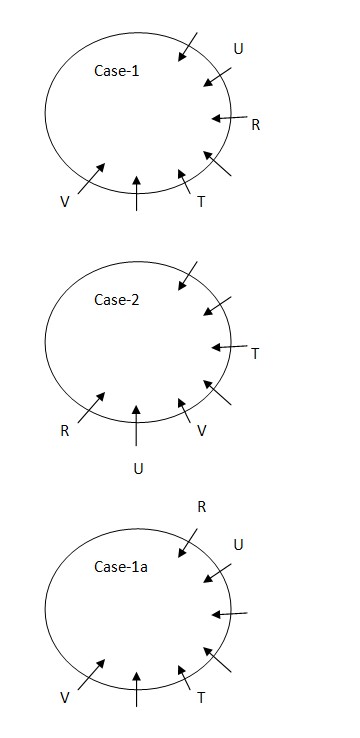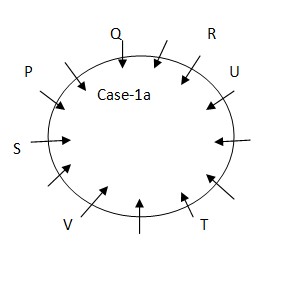Question
How many persons are sitting around the circular
table? Study the following information carefully and answer the below questions. A certain number of Persons are sitting around the circular table facing the center. V sits second to the left to T. Two persons are sitting between T and U. R and U are sitting adjacent to each other. The number of persons sitting between T and R is the same as between T and S. Q sits exactly in the middle of P and R. R sits fifth to the left of S. P does not sit third to the right of U. Not more than one Person sits between Q and RSolution
We have, V sits second to the left of T, Two persons are sitting between T and U, R and U are sitting adjacent to each other, From the above condition, there are three possibilities.  Again we have, The number of persons sitting between T and R is the same as between T and S From the above condition case-1 gets eliminated.
Again we have, The number of persons sitting between T and R is the same as between T and S From the above condition case-1 gets eliminated.  Again we have, Q sits exactly in the middle of P and R, R sits fifth to the left of S, P does not sits third to the right of U. Not more than one person sits between Q and R. From the above condition case-2 gets eliminated. Case-1a shows the final arrangement.
Again we have, Q sits exactly in the middle of P and R, R sits fifth to the left of S, P does not sits third to the right of U. Not more than one person sits between Q and R. From the above condition case-2 gets eliminated. Case-1a shows the final arrangement. 
If ‘F’ is related to “Hindustan Times’ and ‘H’ is related to ‘Punjab Kesari’ in a certain way based on t...
Who among the following has ordered from Meesho?
Four of the following five are related to each other in some way and thus formed a group. Choose the one which does not belong to that group?
Who among the following person sits fourth to the left of P?
Four of the following five are alike in a certain way and hence form a group. Who among the following person does not belong to that group?
B work who among the following banks?
What is the position of O with respect to W?
What is the difference of ages of U and S?
How many person sit between tallest person and shortest person?
Six persons R, S, T, U, V, and W are sitting around a circular table facing towards the center of the table but not necessarily in the same order. S do...
Relevant for Exams:


